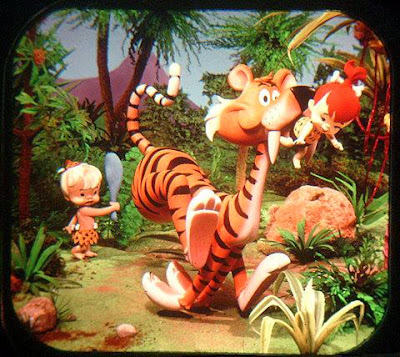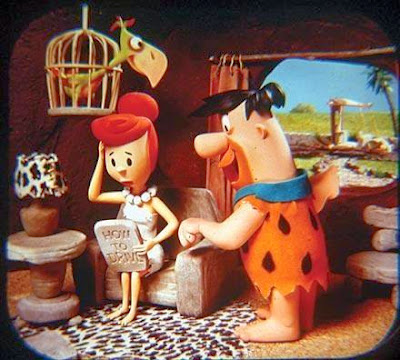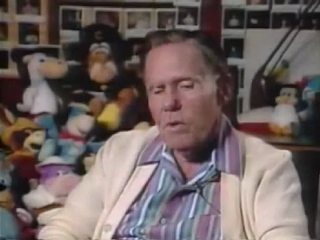The beginning of the Hanna-Barbera story would seem cut and dried. It’s been told so many times. Poor Bill Hanna and Joe Barbera were tossed into the cold by MGM in 1957, formed their own studio, came up with “Ruff and Reddy” later in the year, then created “The Huckleberry Hound Show” the following year, and then “The Quick Draw McGraw Show” the year after that, hiring new staff along the way and replacing writer Charlie Shows with Mike Maltese and Warren Foster from Warner Bros.
Well, it’s basically true. But a few other things happened as well that neither Bill Hanna nor Joe Barbera documented in their autobiographies. As we mentioned in THIS POST, characters named Ruff and Reddy were copyrighted on May 26, 1956 by Shield Productions, a company co-owned by Bill Hanna, Mike Lah and MGM artist Don Driscoll, more than a year and a half before they ever appeared on TV from the efforts of H-B Enterprises (and despite claims by Barbera that he created the characters). And a journey through the pages of Variety published contemporaneously provides us with a little additional information about the studio’s earliest years. It’s a story of cartoons in earlier-than-expected development and hirings of people who never got credit on a single cartoon.
As the trades reported, H-B Enterprises formed in early July 1957. “Ruff and Reddy” premiered on December 14th, but H-B had been working on other cartoon ideas before then and Columbia Pictures, which owned a good chunk of the company, picked up a couple. Here’s Variety from November 27, 1957.
That’s right. “Super Snooper” was in development almost two years before Snooper and Blabber ever appeared on “The Quick Draw McGraw Show.” Whether it’s the same concept that appeared on Quick Draw is unknown and the answer may be buried in some old Hanna-Barbera files somewhere. We did get a comment on the blog in August 2010 from a reader who had a photostat of a Jinks model sheet with the name “Snooper” on it. To the right, you see a picture of it mined from the internet.
So where’s Huckleberry Hound, you ask? Or Pixie and Dixie? Joe Barbera said in his autography they were developed around the same time as Yogi. The number of cartoons mentioned works out to three series of 26 each, and that’s more or less what made up the first season of the Huck show. So Variety would be appear to be missing a series.
As we all know, the studio sold Huck to Kellogg’s in June 1958 and the show debuted to much acclaim the following September. But what happened to Super Snooper? Here’s Daily Variety from November 19, 1958 (thanks to Kliph Nesteroff for the clipping):
So where’s Quick Draw McGraw in all this? The first reference to him in the trade paper I can find is from December 16, 1958 but he must have been in development before that.
Oh, I know what you’re saying now. What about Augie Doggie and Doggie Daddy? We mentioned in THIS POST that they had been conceived by January 1959 as Pete and Repete. Evidently, the newspaper writer we quoted must have read Variety. Here’s what the trade paper revealed on January 8, 1959:
(As a side note, the Copyright Catalog isn’t the best of sources. For example, the Huck cartoons in the first season were copyrighted in 1958 and early 1959 but don’t appear in the catalogue for that year. They appear, instead, in the 1963 catalogue).
The studio was also working on one other animated series which doesn’t seem to have had anything to do with Quick Draw, Snooper, father and son dogs or anything else. This is from Variety, December 31, 1958:
Meanwhile, Variety reported on May 2, 1958 that NBC picked up “Ruff and Reddy” for another season (to be sponsored by candy maker Mars, Inc.) and on August 13th that Kellogg’s had bought national sponsorship of the Quick Draw show and would air it in more than 150 markets starting in September, resulting in Hanna-Barbera turning out 39 hours of animation a year at that point. That, naturally, meant an expansion of studio space and staff. In fact, the studio hired people whose names you never saw on a Hanna-Barbera cartoon. We’ll post about that later.
Well, it’s basically true. But a few other things happened as well that neither Bill Hanna nor Joe Barbera documented in their autobiographies. As we mentioned in THIS POST, characters named Ruff and Reddy were copyrighted on May 26, 1956 by Shield Productions, a company co-owned by Bill Hanna, Mike Lah and MGM artist Don Driscoll, more than a year and a half before they ever appeared on TV from the efforts of H-B Enterprises (and despite claims by Barbera that he created the characters). And a journey through the pages of Variety published contemporaneously provides us with a little additional information about the studio’s earliest years. It’s a story of cartoons in earlier-than-expected development and hirings of people who never got credit on a single cartoon.
As the trades reported, H-B Enterprises formed in early July 1957. “Ruff and Reddy” premiered on December 14th, but H-B had been working on other cartoon ideas before then and Columbia Pictures, which owned a good chunk of the company, picked up a couple. Here’s Variety from November 27, 1957.
Geo. Sidney Sells NBC 52 Cartoons
NBC bought 52 cartoons in the series called "Ruff And Ready" from H-B Enterprises for showing on Saturday mornings. It was part of a package negotiated by Screen Gems and will include Columbia one-reel comedies.
SG has also ordered from H-B 78 cartoons titled "Super Snooper" and "Yogi Bear."
H-B was formed last spring by George Sidney, prexy, and animators Joe Barbara and William Hanna. Company has also been active in the commercial tv [rest of story unavailable].
That’s right. “Super Snooper” was in development almost two years before Snooper and Blabber ever appeared on “The Quick Draw McGraw Show.” Whether it’s the same concept that appeared on Quick Draw is unknown and the answer may be buried in some old Hanna-Barbera files somewhere. We did get a comment on the blog in August 2010 from a reader who had a photostat of a Jinks model sheet with the name “Snooper” on it. To the right, you see a picture of it mined from the internet.
So where’s Huckleberry Hound, you ask? Or Pixie and Dixie? Joe Barbera said in his autography they were developed around the same time as Yogi. The number of cartoons mentioned works out to three series of 26 each, and that’s more or less what made up the first season of the Huck show. So Variety would be appear to be missing a series.
As we all know, the studio sold Huck to Kellogg’s in June 1958 and the show debuted to much acclaim the following September. But what happened to Super Snooper? Here’s Daily Variety from November 19, 1958 (thanks to Kliph Nesteroff for the clipping):
Hanna, Barbera Set Half-Hour Mystery Cartoon VidseriesThe Variety story makes it appear Snooper and Blabber were to be the stars of the new show. And, indeed, the studio did test for new voices. Elliot Field was the original voice of Blab and you can hear him in the first four cartoons. He also did some work on one Quick Draw McGraw cartoon, as did Peter Leeds and Vance Colvig, Jr., later the voice of Chopper in the duck series.
George Sidney's Hanna & Barbera Productions will film "Snooper and Blabbermouse," half-hour mystery cartoon teleseries for Screen Gems distribution.
Company currently is testing voices for the lead and secondary voices in the new project. Firm also produces "Ruff And Reddy" and "Huckleberry Hound."
So where’s Quick Draw McGraw in all this? The first reference to him in the trade paper I can find is from December 16, 1958 but he must have been in development before that.
H-B Staff Gets BonusWhether Quick Draw and Snooper were planned as stars of two separate half-hour shows at that point is unclear.
Some 200 employes of Hanna and Barbera Enterprises will receive a paid week's vacation next week as a special Christmas bonus. Production of "Ruff and Reddy,""Huckleberry Hound,""Quick Draw McGraw" and "Snooper and Blabbermouse" will be halted during the holiday.
Oh, I know what you’re saying now. What about Augie Doggie and Doggie Daddy? We mentioned in THIS POST that they had been conceived by January 1959 as Pete and Repete. Evidently, the newspaper writer we quoted must have read Variety. Here’s what the trade paper revealed on January 8, 1959:
Screen Gems OK's New H& B CartoonsBut Pete and Repete didn’t become Doggie Daddy and Augie Doggie right away. They had a new name by the January 28th edition of Variety.
Screen Gems yesterday gave the go-ahead to Hanna & Barbera Productions for full production on “Pete and Repete,” new half-hour cartoon series to be launched next fall.
H&B are already in production on two other cartoon series for Screen Gems, “Quick Draw McGraw” and “Snooper and Blabbermouse.” H& B are searching for offbeat voice characterizations for “Pete,” a father and son format.
Besides new entries, H& B are continuing with production of their current “Ruff [and Reddy” and Huckleberry Hound” shows].
Hanna-Barbera Plots 197 Cartoons“Arf and Arf”? Could the name be any lamer? It’s worse than “The Gladstones,” which was an interim name given briefly to Stone Agers Fred and Wilma after the original name, “The Flagstones,” had been quickly changed because of the threat of litigation from the syndicators of the comic ‘Hi and Lois’ (last name, Flagston). The change to “Arf and Arf” may have been just as quick, and for the same reason. In the 1959 Catalog of Copyright Entries is a listing for Pete and Repete, the Glacier National Park bears who were comic characters. How long “Arf and Arf” lasted is unknown; I have a copy of Augie Doggie and Doggie Daddy model sheet dated April 1959 so that may be an indication.
A record production year for cartoons has been set by Hanna and Barbera Productions for the coming year, with 197 cartoons to be made for tv during 1959. This includes segments of "Ruff and Reddy,""Huckleberry Hound,""Arf and Arf,""Quick Draw Mc Graw," and "Snooper and Blabber," as well as commercial and industrial animation.
Firm headed by William Hanna and Joseph Barbera, as v.p.'s, and George Sidney as prexy [rest of story unavailable]
(As a side note, the Copyright Catalog isn’t the best of sources. For example, the Huck cartoons in the first season were copyrighted in 1958 and early 1959 but don’t appear in the catalogue for that year. They appear, instead, in the 1963 catalogue).
The studio was also working on one other animated series which doesn’t seem to have had anything to do with Quick Draw, Snooper, father and son dogs or anything else. This is from Variety, December 31, 1958:
Hanna-Barbera Prod'ns Plots New TV CartoonsThis cartoon is an absolute mystery. I’ve found nothing about the story (let alone why H-B would buy one from the outside), which Edward Fiske is being referred to, whether the series went into production, if any animation or artwork from it exists, or whether the whole thing was a publicity plant by the studio. Variety makes no further mention of the series that I’ve been able to find. Fans of truly bad TV cartoons will recall that around this same time, Sam Singer’s Trans Artists Productions plunked a Mexican boy in a mind-numbingly wretched cartoon series called “Bucky and Pepito” (see right). It was already in production at the time Variety announced “Nino;” Variety squibbed on November 26, 1958 that the first seven cartoons had already been completed.
"Nino From Coconino," original story by Edward Fiske, has been bought by Hanna and Barbara Productions for a cartoon teleseries and will go into production in February. New series, which has a Mexican boy as the hero, will be on a five-a-week schedule, with each episode a separate story.
Meanwhile, Variety reported on May 2, 1958 that NBC picked up “Ruff and Reddy” for another season (to be sponsored by candy maker Mars, Inc.) and on August 13th that Kellogg’s had bought national sponsorship of the Quick Draw show and would air it in more than 150 markets starting in September, resulting in Hanna-Barbera turning out 39 hours of animation a year at that point. That, naturally, meant an expansion of studio space and staff. In fact, the studio hired people whose names you never saw on a Hanna-Barbera cartoon. We’ll post about that later.














































































































































































